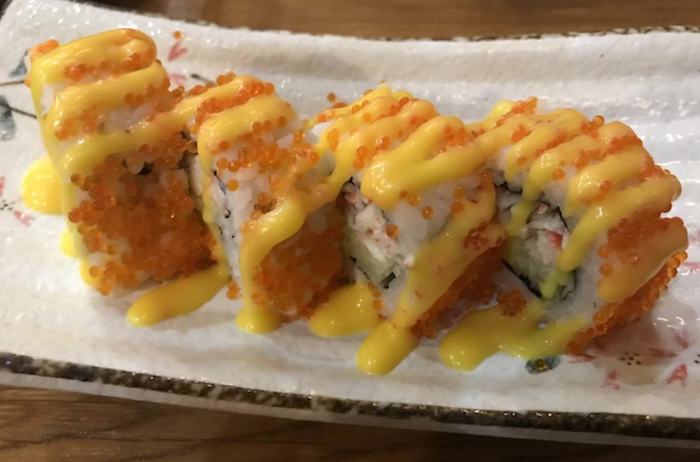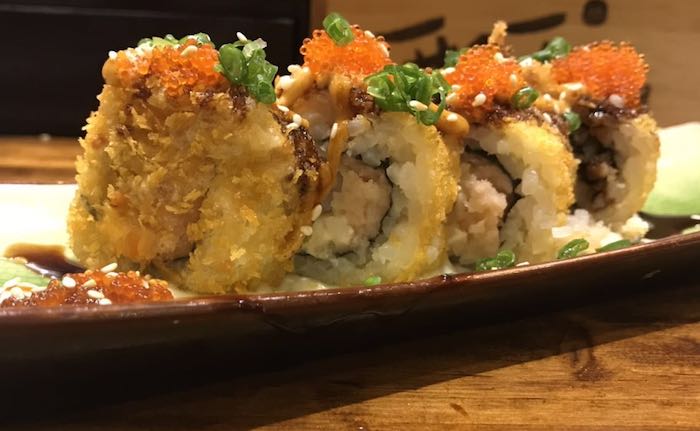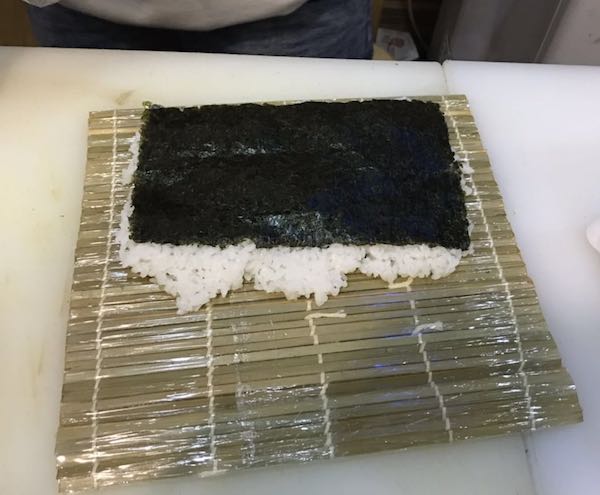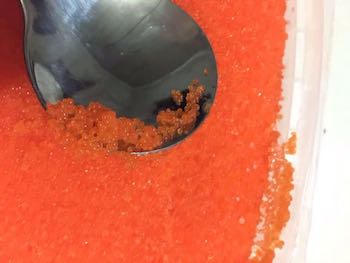We are reader supported. When you purchase through links on our site, we may earn an affiliate commission. Also, as an Amazon affiliate, we earn from qualifying purchases.

If you have eaten sushi before, you have probably come across the different types of fish roes that are popular for their crunchy texture and vibrant colors. They are so versatile in nature that they can be used as fillings, toppings, or even for garnishing sushi.
These tiny little orange balls that are often dyed to acquire a red, green, or black color sit pretty on sushi rolls, nigiri sushi, sashimi platter, and so on. Their crunchy flavor adds a refreshing break from the soft sushi rice and firmer meat/ fish or seafood variety.
While tobiko comes first to the mind when we talk about roe, another significant variety of fish egg or roe is known as masago. Interestingly, many restaurants use masago as a substitute for tobiko, and it’s difficult to tell the difference unless you are an expert.
Contents
What Is Masago?
Masago is the roe or egg of Capelin or smelt, a kind of fish that is found in the Atlantic and Arctic oceans. Just like salmon, Capelin is also native to Iceland and lives in the sea. However, it often travels to the freshwater rivers in order to lay eggs. You can buy it on this page
Masago is one of the smallest sizes of roes and derives its name from the Japanese word ‘masa’ which means sand, resembling the size of sand’s particles. The roe is approximately 1 millimeter in diameter, and the best part is that they are extremely low on calories and fat, but high in omega-3.
This capelin roe is known to have a clumpy or sticky consistency that enables it to easily stick to any type of food. It can enhance the overall flavor, texture, and appearance of any dish. The natural crispy texture is another advantage that works in its favor.
How Is Masago Harvested?
Capelin belongs to the smelt family and they are often considered as forage fish. They are an essential source of food for large predators such as seabirds, codfish, whales, and These small sized, silverfish-green fish is known to closely resemble sardines.
Although the flesh of capelin is edible, they are most sought after to create various other products including fish eggs and fish oil. Nearly 80% of the harvested capelin is used for fishmeal and other products while only 20% is used to get masago.
Female capelin fish start releasing eggs when they are between two to four years of age, and they continue reproducing as long as they live. Masago is harvested when the fish are full of eggs, just before they get the chance to release them.
Right after harvest, the Capelin roe is pale orange in color, so the bright masago you find on sushi is actually marinated or dyed before distribution. In sushi restaurants, you can find masago in bright orange, black, or red color.
What Does Masago Taste Like?
Masago are one of the most prized ingredients used in sushi. Although small in size, don’t go by their face value. These small orange balls are capable of turning a simple sushi dish into something more extravagant and classy.
The capelin roe has a crunchy texture and it tastes salty and sweet at the same time, with a hint of bitterness. If you are a sushi fan, you are sure to relish the savory taste of masago that smells like the ocean but is not overpoweringly fishy.
Due to its amazing taste, masago is popularly used as toppings in uramaki and as fillings in California rolls. Many sushi restaurants choose to use masago instead of tobiko because they taste and look great, without being too pricey as tobiko.
What Do You Know About Smelt Fish
To understand masago and its unique characteristics better, it’s important to delve a little deeper in its origin. As already mentioned above, these eggs come from a small fish species called Osmeridae. They have a wide range of smaller classifications that include the rainbow smelt, capelin, and the European smelt.
As roe is the word for fish eggs, smelt roe is often used to refer to the eggs derived from Smelt fish. Similar to caviar, these fish roe refer to eggs from sturgeon family. Although the meat of smelt fish is rarely used, the eggs or masago are extremely popular in sushi restaurants around the world.
How To Use Masago (Capeline Roe) In Sushi
As toppings and garnishes:
This is perhaps the most common use of masago and novices often believe this is the only way they are eaten. The bright orange eggs not only make sushi rolls look aesthetically pleasing but also add a crunchy texture to it.
Masago is mostly added to an inside out California roll when the sushi rice is on the outside. The sticky consistency of the rice helps in sticking the roe. While I prefer sprinkling masago on sushi rice before flipping the nori, some people may add masago after they are done rolling.

To do this, place the nori on the bamboo mat, take a medium ball of sushi rice and spread it over the nori, pressing gently with fingers. Now, take a tablespoon of masago and generously spread it over the rice and press gently to ensure that it sticks to rice, then flip the nori.
As fillings inside the roll:
If your experience about sushi is limited then you may not have heard about this, but you can actually add masago as fillings. It lends a distinct flavor to the roll without being overpowering. You may add a line of masago to maki rolls to enhance the taste and add crunchiness to it.
To do this, first place the main filling such as cucumber strips, avocado slices, or raw fish in a row. Then take a teaspoon of masago and make a line just beside the main fillings. Add more if needed and then start rolling.
In gunkanmaki, the nori is wrapped around a bed of sushi rice to form a boat shape. I like to mix masago with spicy mayo and add a spoonful of the mixture on the top. As masago is sweet and salty in flavor, mixing it with mayo adds a hint of spiciness to the dish.
Related Article: 30 Good Ideas for Sushi Roll Fillings
As decorations on sushi:
In some varieties of sushi such as a caterpillars roll or Godzilla roll (click to see recipe), presentation plays a key role. These rolls have interesting names based on the way they appear on the outside. In caterpillar rolls, for example,

Some chefs may add a dollop of masago on almost every type of sushi to enhance the presentation when serving the pieces on a plate. Although originally pale orange in color, they are often dyed with squid ink to turn them black or with wasabi to turn them green for presentation.
With nigiri and sashimi:
Masago is not restricted to rolls alone, but can also be used in other sushi varieties such as sashimi and nigiri. Sashimi refers to just a fine and thin slice of raw fish or meat. It may be served with soy sauce, wasabi, and ginger.
Sashimi may be made with just masago served in a cup made out of thin avocado slices, peel of cucumber or lime. Nigiri, on the other hand, is a rice bed topped with raw fish or seafood and shaped with hands. When masago is used in nigiri, it may be served in a bowl or wrapped with dried seaweed.
Related Article: Difference Between Nigiri, Sashimi, Sushi Roll, Hand Roll, Gunkan Sushi
Difference Between Masago And Tobiko
Sushi beginners often confuse between masago and tobiko because both look almost the same, and the taste is almost similar. However, a sushi connoisseur has an eye for finer details and they can immediately tell even the slightest difference in flavor, texture, and color.
Masago is the dull and naturally smaller and paler eggs of Capelin smelt, while tobiko comes from flying fish. So, tobiko or flying fish roe is slightly bigger and brighter. They are also more flavorful and you get a burst of salty and sweet flavors when you bite it. They also come dyed in black, green, and red colors.
In terms of flavor, you may call masago the little younger brother of tobiko because they are less intense and distinct when compared. Masago is widely used in restaurants to substitute tobiko as they are also less expensive and readily available. In some recipes like gunkan nigiri, some fish lovers may prefer tobiko for a more intense taste.
People who love sushi but are not a fan of fishy smell prefer masago to its big brother due to its subtle flavor and taste. In some restaurants, masago may be colored or dyed to use them in recipes even if the menu called for flying fish roe.
What Is The Difference Between Masago And Caviar
Both masago and caviar are interchangeable terms used to refer fish eggs, but there’s a difference between the two. While roe is used to refer female fish eggs or male fish sperms, caviar is a term used to refer to roe that has been cured and kept in tins for aging and storage.
In the U.S. and Canada, any type of caviar is believed to have come from the sturgeon roe only. If the caviar contains roe extracted from other fish species, they must be labeled with the name of the fish such as trout roe, salmon roe, whitefish roe, and carp roe. The roe of shellfish may also be used for making caviar, but they are usually labeled as caviar substitute.
So, while masago is used to specifically refer to the eggs derived from Capelin fish only (belonging to the sturgeon family), caviar is used for all types of cured roes from any fish belonging to the sturgeon family. While there are several species of fish in the sturgeon family, beluga produces the most expensive type of caviar.
How Is Fish Roe Cured To Make Caviar?
To make caviar from roe, the female eggs are harvested three days before they are ready to spawn as the eggs are flavorful and taut at this time. If harvested early, the eggs are gooey and if they are taken late, they turn into a milky mess, hence timing is everything.
The eggs are then rinsed thoroughly to remove the membranes. Salt is added and it is allowed to rest for some time for the salt to cure the eggs. The brine solution is then drained and the eggs are transferred to special containers. Some types of caviars may be pasteurized to increase their shelf life.
In the past, Iran and Russia were the main producers of caviar and they mostly relied on sturgeon species such as sveruga, oscietra, and beluga. Due to the overfishing of sturgeons to extract caviar, they are now farmed in a controlled fashion in France.
Some of the popular types of caviar used in making sushi come from paddlefish, hackleback, trout, and salmon. Tobiko and masago are two similar-looking fish roe that is cured and dyed to use as caviar.
Where To Look For Masago Sushi
If all that information about masago and looking at the luscious orange fish eggs make you hungry, visit a reputed sushi restaurant in your area. Most of the sushi eateries will have at least one variety of sushi rolls that contain masago. Look for it in the menu descriptions or ask the server to help you.
Alternatively, you can make your own masago sushi at home. If you don’t find the fish eggs at an Asian store near you, order them online. Capelin roe is usually sold frozen, packed in jars. Most of them are cured varieties (cavalier) with a high content of salt.
As masago is harvested during the breeding season of capelin smelt fish, you can buy fresh roe during those months. Check your Asian grocery store or online marketplace for fresh roe in the winter or early spring season. If you are craving for masago sushi, here are some recipes you may try at home.
Best Sushi Recipes Using Masago
Now that you know masago a bit more closely than before, here are a few recipes that can give you the excuse to use this tantalizing delicacy to enhance your rolls and cones:
#1. California Sushi Roll with Masago
Ingredients:
• Short grain Japanese rice
• Vinegar, salt, and sugar for seasoning rice
• Roasted seaweed (nori)
• Imitation crab sticks
• Japanese or English cucumber
• Avocado
• Capelin roe
• Roasted sesame seeds
• Lemons
The first step is to cook sushi rice with the right quantity of water and season it with vinegar, sugar and salt. Read here for full direction on how to make sushi rice on a cooker or pot.
Peel the cucumber, julienne cut to make thin strips and remove the seed.
Cut the avocado into half in 360 degrees, twist and remove pit, peel the outer skin and make thin slices. Add lemon juice to avocado to prevent them from turning brown.
Take imitation crab sticks and cut them into two parts lengthwise and keep aside.
Place a bamboo mat on the working area and cover it with a plastic sheet.
Moisten your hands and take a medium ball of sushi rice. Spread it evenly on the nori leaving a half-inch gap on the sides.
Take a spoonful of masago and sprinkle it all over the layer of rice (if you don’t wish to add masago now, you may do this later).

Flip the nori to have the rice layer facing downwards. Now add two slices of avocado in a row, then two crab sticks beside it and then the cucumber.
Now, pull the bamboo mat that’s close to you and start rolling, pressing gently to ensure that you don’t disturb the eggs.
For this reason, many people prefer to add masago after making a compact roll. Remove the plastic wrap and sprinkle some masago over the roll.
Take a sharp Japanese knife like this and then cut the roll into 6-8 equal pieces. Make sure you moisten the knife in between each cut to prevent rice or
Serve the sushi pieces with pickled ginger, soy sauce, and wasabi.
#2 Raspberry Masago Sushi Roll Recipe
Ingredients:
• Seasoned sushi rice
• Frozen raspberries
• Masago
• Sushi-grade salmon
• Imitation crab sticks
• Japanese cucumber
Cook sushi rice at least 30 minutes before you intend to start making rolls. Read this article to find out how to cook and season sushi rice in a cooker or pot.
To prepare the masago, you will first need to defrost the frozen raspberries and put them in the juicer to get the luscious red juice in a bowl.
Now, add masago to the raspberry juice and let it sit for about 10 minutes. The longer you leave, the better but I would say 10 minutes is enough. Drain to remove excess juice and spread out the dyed red masago on a tray.
Peel the cucumber, remove seeds and make long strips. Similarly, make thin slices of raw salmon and cut the crabsticks into half.
Now, put the bamboo mat on the working area. Place half of the Nori over the bamboo mat. Moisten your hands and spread out a cup of sushi rice to make an even layer.
Flip over the nori to have the rice facing downwards. Now, arrange two slices of raw salmon in a row, put cucumber sticks beside it and crab sticks over the cucumber.
Lift the bamboo mat from your end and start rolling, pressing, and tucking gently to get a compact cylindrical form.
Now, roll this compact cylinder over the dyed masago and keep rolling until masago covers the entire surface beautifully.
Cover the sushi roll with a plastic wrap and use a sharp Japanese knife to cut 6-8 equal pieces with the plastic on. Remove plastic and serve with soy sauce, wasabi, and ginger.
A Quick Way To Make mas At Home

If you are craving to get a fill of delicious masago but are intimidated with the skill needed for rolling sushi, try this simple gunkan maki recipe instead. This type of masago sushi is so easy to make that you can involve kids to have fun preparing them.
To get started, make sure you cook and season sushi rice at least 30 minutes before you plan to enjoy making gunkan maki
Take a regular sheet of nori and cut it into a long strip, preferably a 4 cm high strip.
Now, take a medium ping-pong ball size of sushi rice and place it at the center of the nori strip to cover about one line to create a base for sushi.
Enclose the nori strip around the sushi rice bed tightly to create a cover. Squeeze slightly to ensure that nori sticks to the sushi rice.
Now take a tablespoon of masago and fill up the gap over the sushi rice to create a delicious and breathtaking topping.
How To Use Masago To Make Spicy Mayo Sauce For Sushi
Ingredients:
• 2 tbsp Kewpie mayonnaise
• 2 tbsp Sriracha sauce
• Half tsp fresh lime
• 2-2.5 tsp fresh Masago (Capelin roe)
Take a small bowl and add two tablespoons of Kewpie mayonnaise. Mix it with two tablespoons of Sriracha sauce like this. I would recommend Kewpie mayonnaise prepared at home for this recipe; however, you may also use the store-bought one.
Next, squeeze the juice of half a lemon over the mayonnaise and Sriracha sauce mixture. Don’t use the entire lime because too much lime with make the consistency runny.
Now, add two teaspoons of Masago (Capelin roe) to the mixture and stir to make an even mix. Take the mixture to see if you need to adjust the heat. You may need to add more Sriracha sauce or Kewpie mayonnaise to suit your taste.
If you are feeling creative, cut out thin slices of cucumber or avocado and stick them out from one side of the boat-shaped maki for presentation.
Related Questions
Is masago spicy in flavor?
No, masago has a salty and sweet taste, not spicy. However, it may be mixed with wasabi to give it a green color and enhance its flavor but adding a hint of spice. When it is cured and dyed green using wasabi, it is usually marketed as wasabi caviar.
Where is masago harvested and processed?
Masago harvesting is typically done in the North Atlantic region, including Norway, Iceland, and Newfoundland. Iceland is the biggest producer of masago and they are processed in Taiwan, China, and Japan.
What is the right method for handling masago
After harvesting, the fresh masago is stored in the coldest area of the refrigerator at 28-32F for maximum shelf life. Masago can stay good for a long period of time if frozen properly. They should be kept frozen until required. Once thawed, the shelf life is only about 3 to 5 days.
What is the shelf life of masago?
If handled and stored correctly, masago can stay good for up to one week from the date of harvest when refrigerated and up to one year when frozen.
How many calories in masago
One ounce (28 grams) of masago or Capelin roe contains 40 calories. Fish roe is low in fat and carbohydrates, but rich in protein and healthy fats such as omega-3 fatty acids and so on.
How to store masago after use to prevent degrading quality
Masago comes in a frozen form so thawing it repeatedly when you want to use just a little is not a good idea. I would recommend thawing once by keeping it in the fridge for a day. Then make small portions by separating them into many small cups and refreeze. Next time, you may pull out only one little cup instead of thawing the entire thing again.


Comments
Pingback: How long does Masago last? - Easy Homemade Sushi
Pingback: 15 Most Popular Cooked Sushi To Order in Restaurant - Easy Homemade Sushi
Pingback: Sushi Hand Roll (Temaki Sushi) Guide (Recipes) - Easy Homemade Sushi